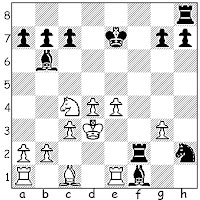About a month ago, Yury Bukayev asked me about the following line of play: 1.e4 e5 2.Nc3 Nc6 3.Bc4 h6 4.Nf3 Nd4.
It had a certain familiarity to it, especially since he suggested 5.Bxf7+!? as a response.
I told him that I would share the opening and my thoughts about it with Readers.
In the meantime, I went to the online ChessLab site and searched for games with the line. I found exactly zero.
Silly me, I was looking in the wrong place. A check of the 26,685 games in The Database showed me 10 examples (White won 9).
One was Wall - Surr, Chess.com, 2010 (1-0, 11), which has already appeared on this blog.
So, clearly, it was time for me to pay attention. First, a brisk walk-through.
1.e4 e5 2.Nc3 Nc6
Starting out as a Vienna Game.
3.Bc4 h6 4.Nf3
The game has transposed to a Semi-Italian Opening, i.e. 1.e4 e5 2.Nf3 Nc6 3.Bc4 h6 4.Nc3 (I usually play the alternative 4.0-0).
4...Nd4
Reaching the diagram above.
This Knight move is seen in the Blackburne Shilling Gambit: 1.e4 e5 2.Nf3 Nc6 3.Bc4 Nd4. The idea in the BSG is that White's greedy 4.Nxe5 can be met by 4...Qg5.
Then the classic BSG punishment by Black follows 5.Nxf7 Qxg2 6.Rf1 Qxe4+ 7.Be2 Nf3#. The pluckier 5.Ng4 is met by 5...d5, with Black advantage. "Best" at this point for White might be 5.Bxf7+ followed by 6.0-0, When Black has the advantage of a piece for two pawns, but many Jerome Gambiteers would be used to that.
Of course, against the Blackburne Shilling Gambit, many Jerome Gambiteers would reply with 4.Bxf7+!? to begin with.
Can the Knight jump work for Black in the delayed form, however? What do you think?



























